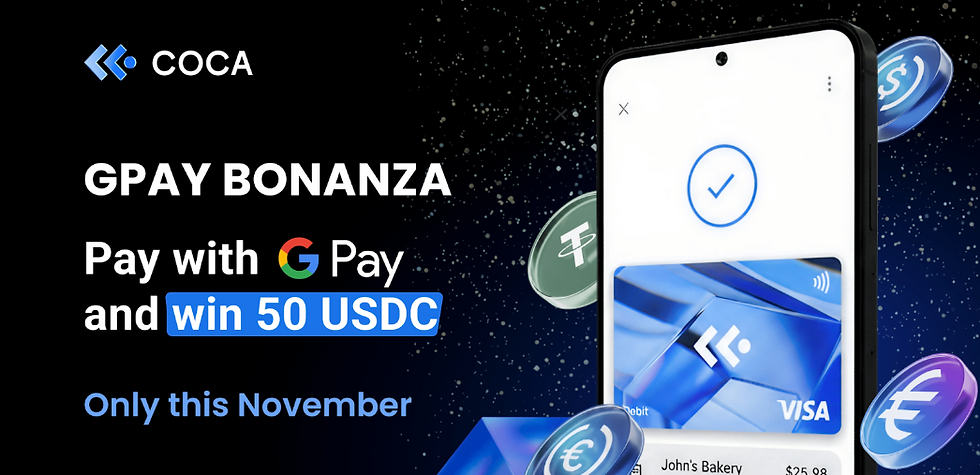Understanding How Crypto Cards Work: A Tech Guide
- porta48
- Sep 1, 2024
- 4 min read

The world of cryptocurrency can feel like its own language sometimes. Between the blockchain, gas fees, and seed phrases, it’s a lot to wrap your head around. And just when you think you’ve got a handle on things, something new pops up, like crypto cards.
You might be wondering, "What’s the point? I can already use my regular debit and credit cards almost everywhere.” But hear me out – understanding how crypto cards work may just reveal a new way to use and think about your crypto.
Table of Contents:
What Exactly are Crypto Cards?
In the simplest terms, a crypto card lets you spend your cryptocurrency for goods and services, just like you would with traditional money. Think of it as a bridge between your digital assets and the everyday places you shop. They work like regular debit or credit cards and are often backed by Visa or Mastercard, making them widely accepted.
Remember those days when you'd have to jump through hoops to buy a simple cup of coffee with Bitcoin? You'd convert it, wait for the transaction, pay exorbitant fees… not exactly convenient. Crypto cards simplify that process.
So, How Do Crypto Cards Work, Really?
This is where the magic happens. While it seems straightforward on the surface (swipe, buy, go.), there's some clever tech behind how crypto cards work. Basically, when you make a purchase, your crypto card converts the required amount of cryptocurrency from your linked digital wallet into fiat currency.
That's the currency the merchant receives, so they don’t even need to be crypto-savvy.
Types of Crypto Cards
Just like their traditional counterparts, there are mainly two types of crypto cards:
Crypto Debit Cards
These work by directly deducting the cryptocurrency equivalent of your purchase from your pre-loaded digital wallet. It's similar to using a prepaid debit card—you can spend what you load onto it, preventing overspending.
Crypto Credit Cards
Crypto credit cards offer a line of credit that you can use for purchases. But instead of repaying with fiat, you make repayments in cryptocurrency, often with interest accruing on the unpaid balance, just like traditional credit cards. They often incentivize users with rewards programs.
The Benefits of Using Crypto Cards
Crypto cards can be game-changers, particularly for people already familiar with or invested in digital currencies. But, knowing more about how crypto cards work might even make non-crypto enthusiasts more receptive. They offer several compelling advantages over traditional payment methods.
Rewards and Perks
Who doesn't love extra perks? Many crypto card issuers offer attractive cashback rewards or points on purchases, usually paid out in cryptocurrency.
For those invested in a particular crypto ecosystem, some cards offer more perks or higher cashback rewards when used within that ecosystem. This is a great way to accumulate crypto over time.
Convenience
Imagine seamlessly paying for a pizza with Ethereum – no need for complicated exchanges or waiting for transactions to clear. Crypto cards streamline cryptocurrency payments, making them much faster than traditional bank transfers.
It makes using cryptocurrency for day-to-day transactions way more user-friendly.
Global Accessibility
Travelers, take note. Because they’re linked to major payment processors, these cards usually function wherever those are accepted, eliminating the need for multiple currency conversions. This can be especially beneficial for international travelers who want to avoid foreign transaction fees.
However, just as with traditional cards, always check for any international transaction fees before you travel.
Are There Downsides to Using Crypto Cards?
While crypto cards are indeed gaining popularity, understanding how crypto cards work also requires knowing potential downsides. It's essential to weigh these drawbacks carefully before diving into the world of crypto cards.
Volatility
One of the biggest concerns revolves around cryptocurrency's inherent price volatility. Say you load your card when Bitcoin is at one price, and then it dips? You might end up spending more Bitcoin to cover the same purchase a few days later. That is easly solved in COCA where you need to top up the card only with stablecoins. So, in that way you don't lose anything because of volatility.
Fees
Always review the fee structure before choosing a crypto card. Charges can range from ATM withdrawal and inactivity fees to annual subscription costs, and they can eat into your crypto holdings.
Conclusion
Crypto cards may just be the next stage of mainstream crypto adoption, providing a seamless link between the digital and physical financial worlds. This post helps you understand how crypto cards work and highlighted benefits and downsides.
Ultimately, understanding how crypto cards work empowers informed decisions about whether incorporating one aligns with your financial goals and needs.
Get Started with COCA
Ready to transform your financial experience? Download the COCA MPC Wallet now and join the revolution:
Download on the App Store
Get it on Google Play
And don't miss out on the vibrant discussions and community support—join us on Discord!

.png)



.png)
Comments